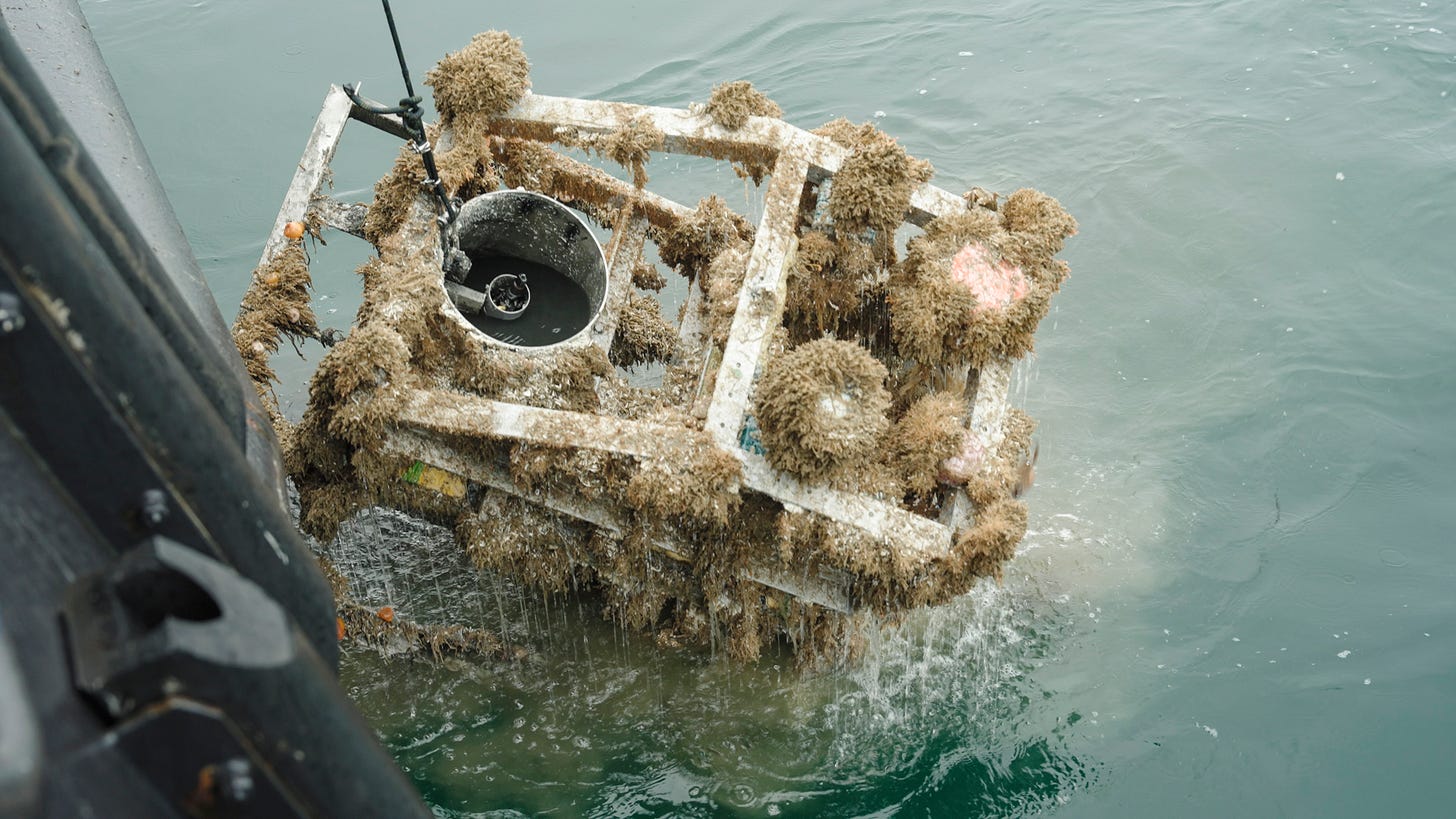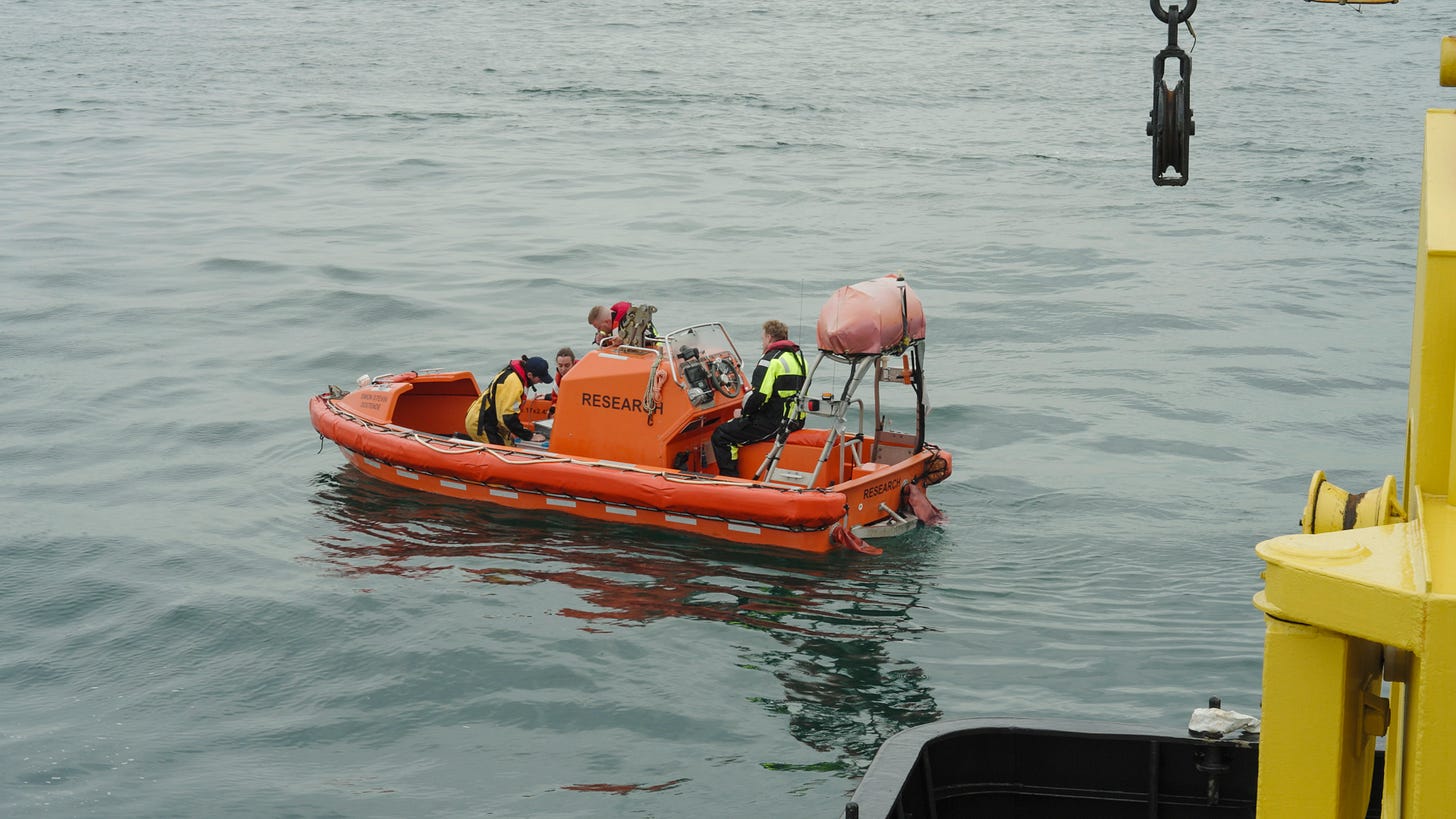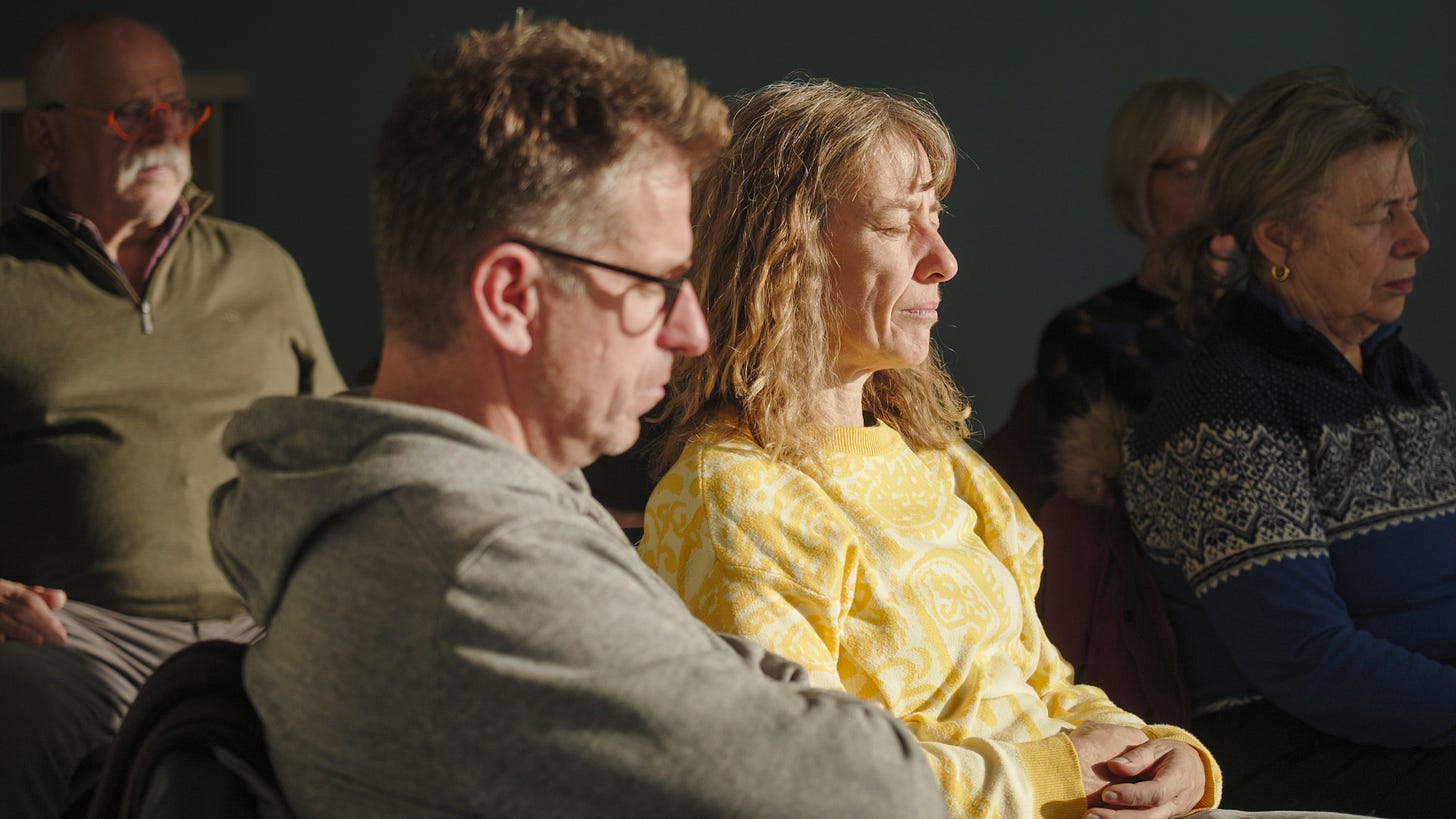The psychological impact of ocean sound with Elise Guillaume
Artist and film-maker Elise Guillaume's Waves of Resonance explores the potential of listening to deepen connection with the underwater world.

In early 2024, Belgian artist Elise Guillaume was selected for the "EMBracing the Ocean" artist-in-residence programme organised by the European Marine Board. Having recently completed Arctic film project Eventual Horizon, in which she was particularly struck by the audience’s emotional responses to her use of sound, Guillaume began to explore the ways in which underwater recordings might engender feelings of surprise, awe or emotional connection with a realm typically outside of the reach of human hearing.
Working with environmental psychologist Marine Severin and acoustic ecologist Clea Parcerisas, Guillaume developed a sound project called Waves of Resonance, incorporating underwater recordings of both anthropogenic (human-made) noise such as pile driving and boat engine revs, and biological sounds of crustacean stridulation, dolphin whistles and fish recorded in the North Sea and the Arctic.
Working at the intersection of psychology, ecology and notions of care in our relationship with the natural world, Guillaume’s work treads the line between hope and grief, following an intuitive thread across disciplines and mediums - whether sonic, visual or installation-based - that asks a familiar but fiendishly difficult question: in what way can artistic practice intervene in and amplify scientific research about the environment?
With Waves of Resonance set to be displayed alongside new work at Guillaume’s next solo exhibition, Par le corps (Through the body), at La Chapelle Jeanne d’Arc - a contemporary art centre located in a deconsecrated chapel in Thouars, France - Guillaume invited her collaborators Marine Severin and Clea Parcerisas to join her in answering a few questions for Through Sounds, providing a multi-disciplinary take on the emotive impact of underwater sound, from the perspectives of an artist, a psychologist and an acoustic ecologist.
Tell me about the background to Waves of Resonance to begin with. What sparked your interest in working with marine sounds?
Elise: Last year, I made Eventual Horizon, a film in which I express a parallel between the experience of mourning a loved one and ecological degradation in the Arctic. It considers grief, in a time of climate crisis, as an active step towards hope. The film’s soundscape is made from Arctic field recordings including the sounds of carving glaciers, melting glaciers and sea ice. When Eventual Horizon started being shown in exhibitions and festivals, the film received emotional responses which gave way to some really meaningful conversations.
While I’ve always been interested in art’s potential to raise awareness and create forms of togetherness, I also question the extent to which art can have an impact. I wanted to explore whether certain marine sounds evoke specific emotions, and if so, whether these emotional responses could deepen our connection with the ocean, to understand if this emotional engagement could enact behavioural change. So, Waves of Resonance is an opportunity to look into that.
What have you discovered or learned so far about ocean acoustics in developing this project? And what emotional impact has it had on you?
Elise: Quite early on in our collaboration, Clea shared a recording of the sound of pile driving for windmill construction in the North Sea. Listening to this high intensity impulse noise was exhausting and violent to some extent. I learnt that recent studies showed that pile driving noise was killing some species of small fish and with the increasing evidence of the damage it produces to marine life, more attention and legislation is currently being put into place to diminish the negative impacts. New technologies to lower the sound levels have been and are still currently being developed. With Clea, I also heard some biological sounds I’d never heard before, like the sound of fish which was amazingly surprising to hear.

Marine: I have learned about the large diversity in ocean sounds and the sometimes surprising nature of these sounds. For example, listening to dolphin whistles is not what I had imagined and I initially thought the sound was anthropic. Listening to crustacean sounds has also been a marvel as I was exposed to sounds I’ve never heard before. Learning about the nature of these sounds gives me a sense of closeness to marine life, making it appear more real and alive.
How big a problem is underwater noise pollution and what challenges do we face in addressing it?
Clea: Underwater noise is a current topic of concern for policymakers, as in recent years there has been growing evidence of the adverse impact it has on marine life. The main source of noise is shipping, which is present overall in the world (see this link for an image), but the recent increase in the development of offshore wind farms is also of growing concern. Piling is a very local, short-timed, extremclimateely loud sound, while shipping is a less loud, global, constant source of noise.

It is complicated to protect the ocean from noise pollution while at the same time not blocking the necessary transition to greener energies such as wind energy, which is expected to double in Europe by 2030. For reducing shipping noise there are currently no plug-and-play solutions, so research is currently designing ships that will be less loud in the future. A common proposal by experts in the meanwhile is to ask ships to slow down, as then they are quieter at the same time that they reduce their carbon emissions. This is ecologically interesting but might go against the expansion and fast-delivery wishes of certain shipping companies.
The only thing playing an advantage to the reduction of underwater noise pollution is that once the polluting source stops, the pollution is not there anymore (which is not the case for chemicals and plastics for example).
How would you like to see this project progress and do you have any further outcomes in mind?
Elise: In terms of how the work will be shown— I’m thinking of Waves of Resonance as a sound project which will express itself through a series of iterations that continue to evolve over time. Similar to the research workshops, every iteration of the work will provide us with new insights, creating a feedback loop of new research for the next iteration of the project. In my next solo exhibition, Par le corps, opening at La Chapelle Jeanne d’Arc on the 22nd March, an iteration of Waves of Resonance will be presented as a surround soundscape in the crypt of the chapel. Through sound spatialisation shaped according to the crypt’s architecture, and a dim green light emanating from a sculptural work made with seaweed, the work hopes to offer an immersive listening experience.

What power do you think sound has to communicate aspects of the climate crisis that other mediums do not?
Elise: As a filmmaker, I find myself increasingly questioning the role and impact of images. In an era where we are inundated with countless visuals every day, it seems we are developing an immunity to their affect—a form of desensitisation, which is perhaps a coping mechanism reaction. Working solely with sound has been fascinating to understand the relationships between image and sound in regards to affect and the climate crisis. During research workshops for Waves of Resonance, some participants described that they conjured images through memory or imagination during their listening experience which then led them to feel a form of proximity towards the ocean and a willingness to protect it. I’m curious about how sound can teach us to see the invisible.

Marine: I think that the climate crisis is mostly communicated through visual mediums, which can enable a strong emotional impact, as already shown in scientific studies. However, much less is known in terms of the impact of using sound in climate communication, although I expect it to also be efficient due to the strong link between nostalgia and sound. Sound can be easily connected to memory and so any positive experience of the coast can potentially be recalled when listening to ocean sounds. Recalling these experiences will likely increase closeness to the ocean and a willingness to protect it. Another dimension is the potential of ocean sounds to induce awe, especially as they are sounds that we are typically not exposed to. Awe makes you feel smaller in comparison to the vastness and grandeur of what you are perceiving. It is a “self-transcendent emotion”, enabling a sense of connection to other entities, which in this case would be the ocean.
What role has listening and natural soundscapes played in your life? Do you have strong memories related to sounds when you were growing up or is this something you have come to as an adult?
Elise: I’ve always loved being outdoors but I started listening to natural soundscapes, perhaps more consciously, as an adult. I got into field sound recording kind of accidently actually. Five years ago, I was on my way to join La Wayaka Current, an artist residency in the Atacama Desert. Just before getting picked up by the organisers, I was robbed and all of my filmmaking gear got stolen. Since I no longer had my own gear, a friend from the residency loaned me their Zoom H5 recorder and some earphones. It was my first time recording sound. I remember listening to the earth cracking as I walked on the desert ground and the howling wind brushing chachacoma plants. I was in awe. Through listening, I discovered a new sense of proximity, presence and wonder towards the earth. Since then, my way of being in the world and how I approach my practice as an artist and filmmaker has completely changed.
Marine: I have always been in love with music but I don’t think I’ve really exposed myself to natural soundscapes before taking part in this project. I remember listening to the soundpiece that Elise created made me feel very nostalgic and made me feel immersed in my prior experiences at sea, such as swimming and hearing that specific echo when you put your head underwater.
What role do you think artistic or creative interventions can play in bringing scientific research to a wider audience?
Marine: I think that artistic or creative interventions can help the public relate to or connect with the scientific research. For me, art is feeling, and so presenting a certain research topic or finding through art enables the public to feel, and as it is well known in psychology, emotion and action are deeply intertwined. I’m not sure however if these feelings always lead to understanding, which is what scientists usually aim to generate, but perhaps in some cases a strong emotion leads to greater action than a solid understanding.
Clea: I think science is very disconnected from the rest of the population, kind of a very tight closed bubble. Scientific results often do not even reach the right policymakers, and it is only by communicating these findings and results with the wider public that they can have a positive impact on society. This cannot be done using scientific language, as it is complicated to understand when not in the field (and even when in the field!), so using art as a means of communication to the wider audience has great potential to act as a very necessary translation tool.
Elise: This is a question I ask myself a lot as an artist. Of course, I agree with Clea and Marine’s points above, but I also think it really depends on the context in which the work is being presented too. Showing an artwork in a public space is very different to showing it in a gallery. Something which I’ve found very special through our collaboration with Marine and Clea is that it is reciprocal. We work together and the project contributes to advancing our respective research and work. So far, the research workshops have taken place in both scientific and cultural contexts with participants from very different backgrounds. My hope is that Waves of Resonance will continue to evolve in multiple contexts and reach even wider audiences.
Elise Guillaume’s new exhibition Par le corps opens at La Chapelle Jeanne d’Arc, in Thouars, France on 20th March and runs until 22nd September 2025.



